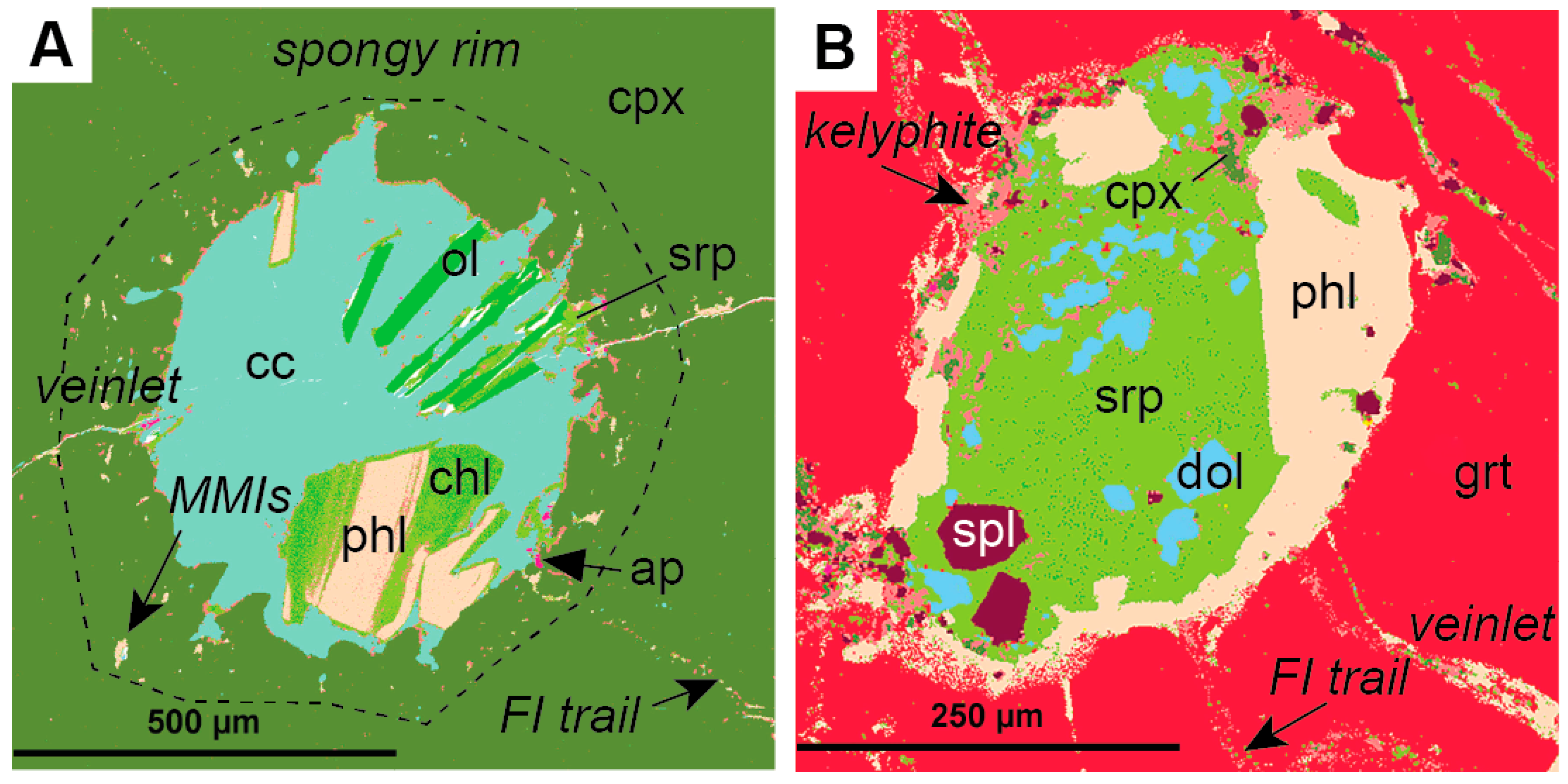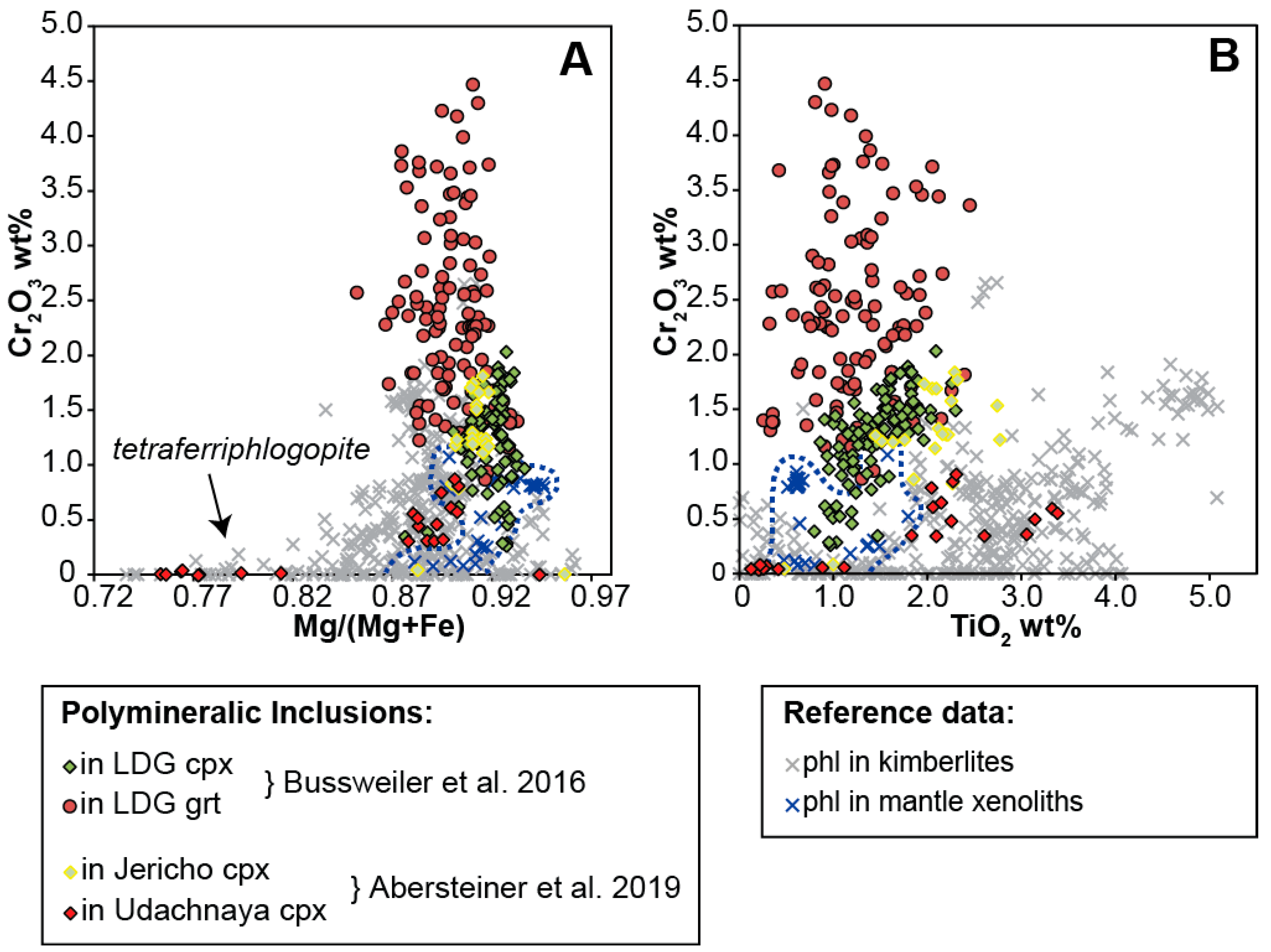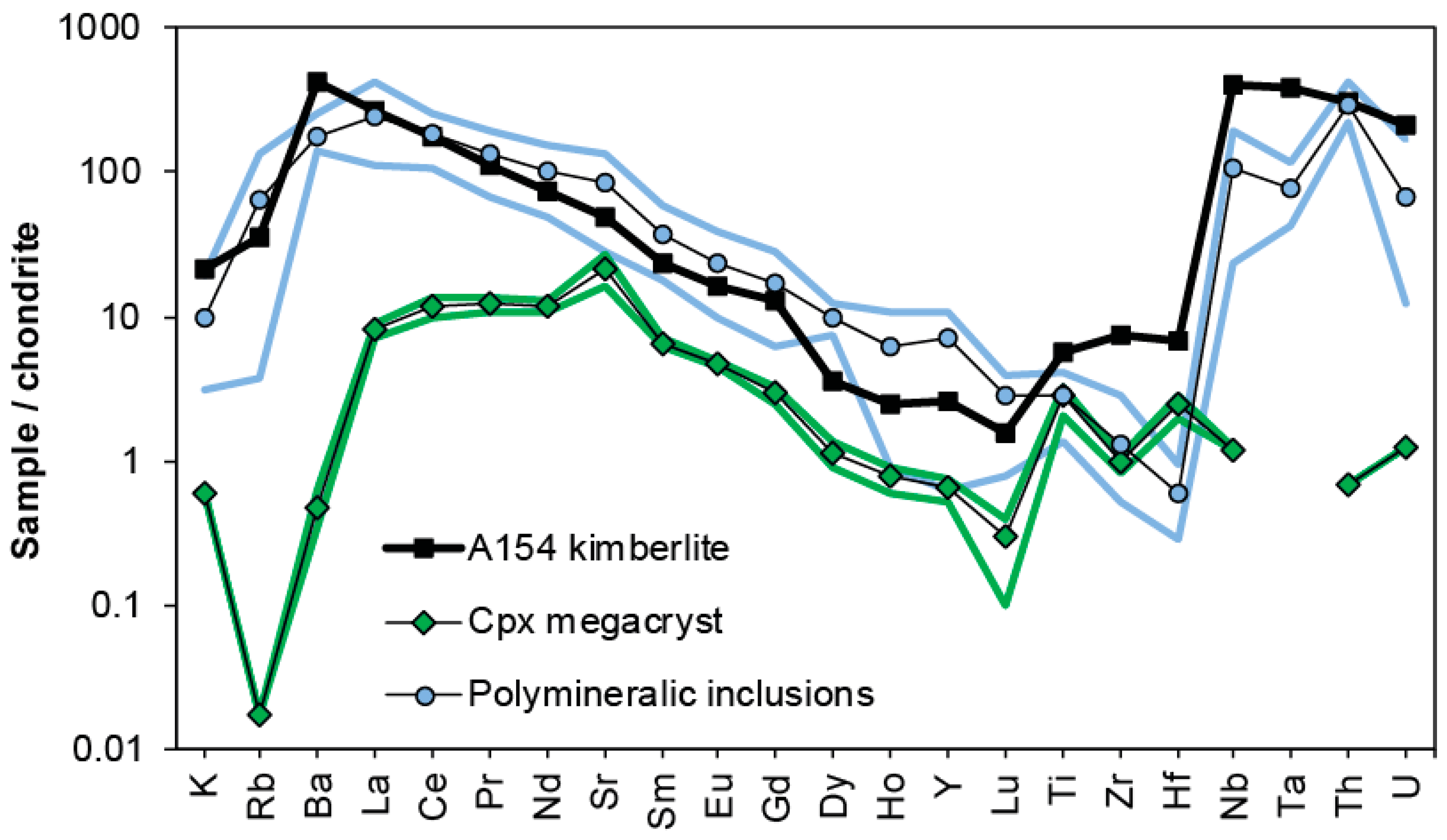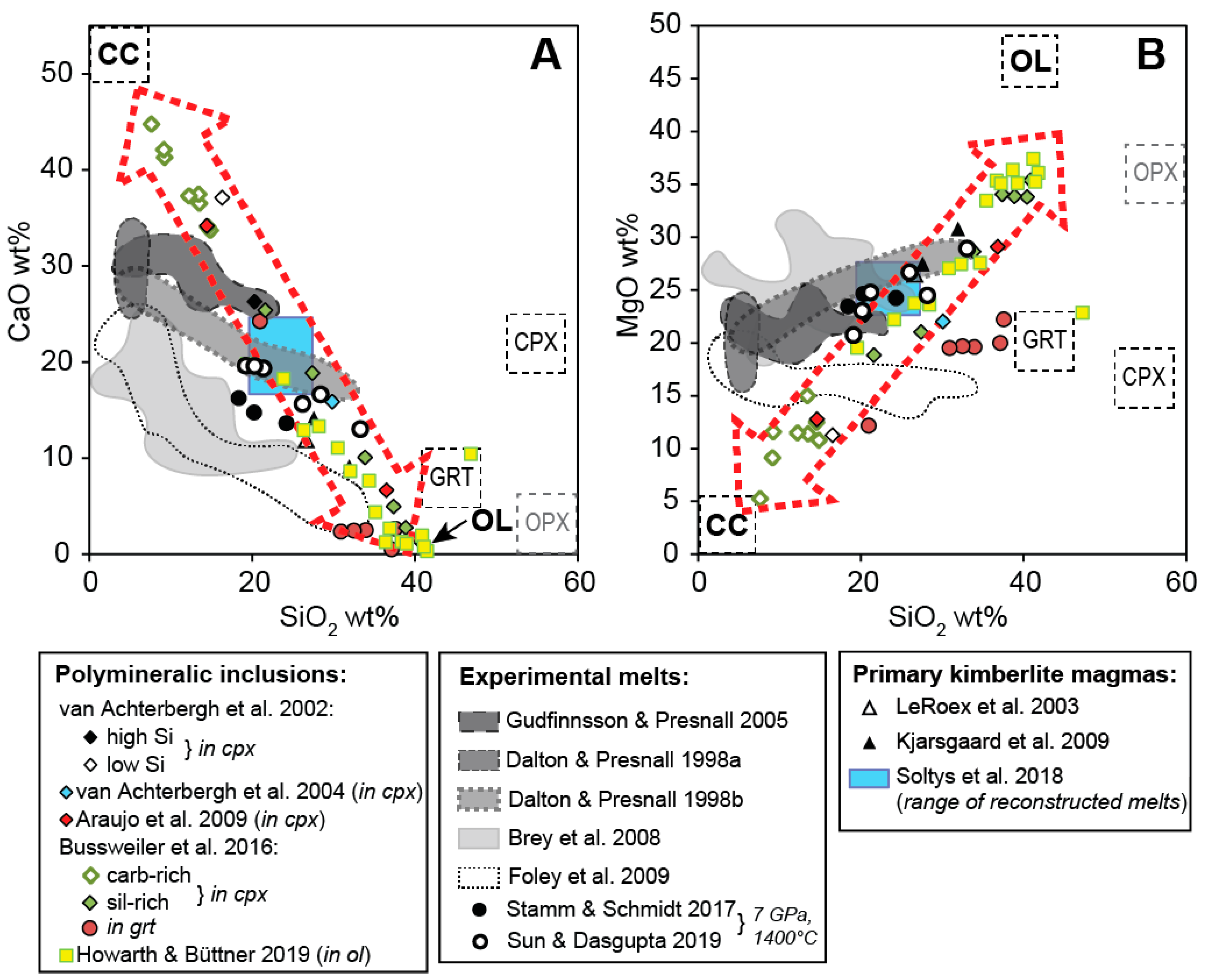Polymineralic Inclusions in Megacrysts as Proxies for Kimberlite Melt Evolution—A Review
Abstract
1. Introduction
Polymineralic Inclusions in Megacrysts—Early Studies to Current Models of Formation
2. Typical Mineralogy of Polymineralic Inclusions
2.1. Relationship to Surrounding MMIs and Veinlets
2.2. Presence of Glass in Polymineralic Inclusions
2.3. Origin of Serpentine in Polymineralic Inclusions
2.4. Importance of Alkali-Halogen-Phases in Polymineralic Inclusions
3. Mineral Chemistry of Typical Phases in Polymineralic Inclusions
3.1. Trace Element Data
3.2. Isotopic Data
4. Insights into the Evolution of Kimberlite from Mantle to Crust
4.1. Depth of Formation of Polymineralic Inclusions
4.2. Composition of the Original Melt
4.3. Differentiation of Kimberlite Melt and Interaction with Megacryst Hosts during Ascent
5. Conclusions and Outlook
Funding
Acknowledgments
Conflicts of Interest
References
- Kamenetsky, V.S.; Kamenetsky, M.B.; Sobolev, A.V.; Golovin, A.V.; Demouchy, S.; Faure, K.; Sharygin, V.V.; Kuzmin, D.V. Olivine in the Udachnaya-East Kimberlite (Yakutia, Russia): Types, Compositions and Origins. J. Petrol. 2008, 49, 823–839. [Google Scholar] [CrossRef]
- Brett, R.C.; Russell, J.K.; Moss, S. Origin of olivine in kimberlite: Phenocryst or impostor? Lithos 2009, 112, 201–212. [Google Scholar] [CrossRef]
- Pilbeam, L.H.; Nielsen, T.F.D.; Waight, T.E. Digestion Fractional Crystallization (DFC): An Important Process in the Genesis of Kimberlites. Evidence from Olivine in the Majuagaa Kimberlite, Southern West Greenland. J. Petrol. 2013, 54, 1399–1425. [Google Scholar] [CrossRef]
- Bussweiler, Y.; Foley, S.F.; Prelević, D.; Jacob, D.E. The olivine macrocryst problem: New insights from minor and trace element compositions of olivine from Lac de Gras kimberlites, Canada. Lithos 2015, 220–223, 238–252. [Google Scholar] [CrossRef]
- Bussweiler, Y.; Brey, G.P.; Pearson, D.G.; Stachel, T.; Stern, R.A.; Hardman, M.F.; Kjarsgaard, B.A.; Jackson, S.E. The aluminum-in-olivine thermometer for mantle peridotites—Experimental versus empirical calibration and potential applications. Lithos 2017, 272–273, 301–314. [Google Scholar] [CrossRef]
- Giuliani, A. Insights into kimberlite petrogenesis and mantle metasomatism from a review of the compositional zoning of olivine in kimberlites worldwide. Lithos 2018, 312–313, 322–342. [Google Scholar] [CrossRef]
- Skinner, E.M.W.; Marsh, J.S. Distinct kimberlite pipe classes with contrasting eruption processes. Lithos 2004, 76, 183–200. [Google Scholar] [CrossRef]
- Mitchell, R.H. Petrology of hypabyssal kimberlites: Relevance to primary magma compositions. J. Volcanol. Geotherm. Res. 2008, 174, 1–8. [Google Scholar] [CrossRef]
- Mitchell, R.H. Paragenesis and Oxygen Isotopic Studies of Serpentine in Kimberlite. Proc. Int. Kimberl. Conf. 2013, 1, 1–12. [Google Scholar]
- Stripp, G.R.; Field, M.; Schumacher, J.C.; Sparks, R.S.J.; Cressey, G. Post-emplacement serpentinization and related hydrothermal metamorphism in a kimberlite from Venetia, South Africa. J. Metamorph. Geol. 2006, 24, 515–534. [Google Scholar] [CrossRef]
- Sparks, R.S.J. Kimberlite Volcanism. Annu. Rev. Earth Planet. Sci. 2013, 41, 497–528. [Google Scholar] [CrossRef]
- Dalton, J.A.; Presnall, D.C. The Continuum of Primary Carbonatitic–Kimberlitic Melt Compositions in Equilibrium with Lherzolite: Data from at 6 GPa. J. Petrol. 1998, 39, 1953–1964. [Google Scholar]
- Gudfinnsson, G.H.; Presnall, D.C. Continuous gradations among primary carbonatitic, kimberlitic, melilititic, basaltic, picritic, and komatiitic melts in equilibrium with garnet lherzolite at 3–8 GPa. J. Petrol. 2005, 46, 1645–1659. [Google Scholar] [CrossRef]
- Brey, G.P.; Bulatov, V.K.; Girnis, A.V.; Lahaye, Y. Experimental Melting of Carbonated Peridotite at 6–10 GPa. J. Petrol. 2008, 49, 797–821. [Google Scholar] [CrossRef]
- Foley, S.F.; Yaxley, G.M.; Rosenthal, A.; Buhre, S.; Kiseeva, E.S.; Rapp, R.P.; Jacob, D.E. The composition of near-solidus melts of peridotite in the presence of CO2 and H2O between 40 and 60 kbar. Lithos 2009, 112, 274–283. [Google Scholar] [CrossRef]
- Stamm, N.; Schmidt, M.W. Asthenospheric kimberlites: Volatile contents and bulk compositions at 7 GPa. Earth Planet. Sci. Lett. 2017, 474, 309–321. [Google Scholar]
- Gervasoni, F.; Klemme, S.; Rohrbach, A.; Grützner, T.; Berndt, J. Experimental constraints on mantle metasomatism caused by silicate and carbonate melts. Lithos 2017, 282–283, 173–186. [Google Scholar] [CrossRef]
- Le Roex, A.P.; Bell, D.R.; Davis, P. Petrogenesis of Group I Kimberlites from Kimberley, South Africa: Evidence from Bulk-rock Geochemistry. J. Petrol. 2003, 44, 2261–2286. [Google Scholar] [CrossRef]
- Kjarsgaard, B.A.; Pearson, D.G.; Tappe, S.; Nowell, G.M.; Dowall, D.P. Geochemistry of hypabyssal kimberlites from Lac de Gras, Canada: Comparisons to a global database and applications to the parent magma problem. Lithos 2009, 112, 236–248. [Google Scholar] [CrossRef]
- Soltys, A.; Giuliani, A.; Phillips, D. A new approach to reconstructing the composition and evolution of kimberlite melts: A case study of the archetypal Bultfontein kimberlite (Kimberley, South Africa). Lithos 2018, 304–307, 1–15. [Google Scholar] [CrossRef]
- Golovin, A.V.; Sharygin, V.V.; Pokhilenko, N.P. Melt inclusions in olivine phenocrysts in unaltered kimberlites from the Udachnaya-East pipe, Yakutia: Some aspects of kimberlite magma evolution during late crystallization stages. Petrology 2007, 15, 168–183. [Google Scholar] [CrossRef]
- Kamenetsky, V.S.; Grütter, H.; Kamenetsky, M.B.; Gömann, K. Parental carbonatitic melt of the Koala kimberlite (Canada): Constraints from melt inclusions in olivine and Cr-spinel, and groundmass carbonate. Chem. Geol. 2013, 353, 96–111. [Google Scholar] [CrossRef]
- Abersteiner, A.; Kamenetsky, V.S.; Kamenetsky, M.; Goemann, K.; Ehrig, K.; Rodemann, T. Significance of halogens (F, Cl) in kimberlite melts: Insights from mineralogy and melt inclusions in the Roger pipe (Ekati, Canada). Chem. Geol. 2018, 478, 148–163. [Google Scholar] [CrossRef]
- Giuliani, A.; Kamenetsky, V.S.; Phillips, D.; Kendrick, M.A.; Wyatt, B.A.; Goemann, K. Nature of alkali-carbonate fluids in the sub-continental lithospheric mantle. Geology 2012, 40, 967–970. [Google Scholar] [CrossRef]
- Giuliani, A.; Phillips, D.; Kamenetsky, V.S.; Kendrick, M.A.; Wyatt, B.A.; Goemann, K.; Hutchinson, G. Petrogenesis of Mantle Polymict Breccias: Insights into Mantle Processes Coeval with Kimberlite Magmatism. J. Petrol. 2014, 55, 831–858. [Google Scholar] [CrossRef]
- Nixon, P.H.; Boyd, F.R. The Discrete Nodule Association in Kimberlites from Northern Lesotho. In Lesotho kimberlites. Maseru; Lesotho National Development Corporation: Maseru, Lesotho, 1973; pp. 67–75. [Google Scholar]
- Mitchell, R.H. Kimberlites: Mineralogy, Geochemistry and Petrology; Plenum Press: New York, NY, USA, 1986. [Google Scholar]
- Mitchell, R.H. Kimberlites, Orangeites, and Related Rocks; Plenum Press: New York, NY, USA, 1995. [Google Scholar]
- Eggler, D.H.; McCallum, M.E.; Smith, C.B. Megacryst assemblages in kimberlite from northern Colorado and southern Wyoming: Petrology, geothermometry-barometry and areal distribution. Mantle Sample Incl. Kimberl. Other Volcan. 1979, 16, 213–226. [Google Scholar]
- Harte, B. Mantle peridotites and processes the kimberlite sample. In Continental Basalt and Mantle Xenoliths; Hawkesworth, C.J., Norry, M.J., Eds.; Shiva: Nantwich, UK, 1983; pp. 46–91. [Google Scholar]
- Boyd, F.; Dawson, J.; Smith, J. Granny Smith diopside megacrysts from the kimberlites of the Kimberley area and Jagersfontein, South Africa. Geochim. Cosmochim. Acta 1984, 48, 381–384. [Google Scholar] [CrossRef]
- Gurney, J.J.; Jakob, W.R.O.; Dawson, J.B. Megacrysts from the Monastery Kimberlite Pipe, South Africa. In The Mantle Sample: Inclusions in Kimberlites and Other Volcanics; American Geophysical Union: Washington, DC, USA, 1979; Volume 16, pp. 227–243. [Google Scholar]
- Garrison, J.R.; Taylor, L.A. Megacrysts and xenoliths in kimberlite, Elliott County, Kentucky: A mantle sample from beneath the Permian Appalachian Plateau. Contrib. Mineral. Petrol. 1980, 75, 27–42. [Google Scholar] [CrossRef]
- Harte, B.; Gurney, J.J. The Mode of Formation of Chromium-Poor Megacryst Suites from Kimberlites. J. Geol. 1981, 89, 749–753. [Google Scholar] [CrossRef]
- Schulze, D.J. Cr-Poor Megacrysts from the Hamilton Branch Kimberlite, Elliott County, Kentucky. Dev. Petrol. 1984, 11, 97–108. [Google Scholar]
- Kostrovitsky, S.I.; Malkovets, V.G.; Verichev, E.M.; Garanin, V.K.; Suvorova, L.V. Megacrysts from the Grib kimberlite pipe (Arkhangelsk Province, Russia). Lithos 2004, 77, 511–523. [Google Scholar] [CrossRef]
- Moore, A.; Belousova, E. Crystallization of Cr-poor and Cr-rich megacryst suites from the host kimberlite magma: Implications for mantle structure and the generation of kimberlite magmas. Contrib. Mineral. Petrol. 2005, 149, 462–481. [Google Scholar] [CrossRef]
- Kopylova, M.G.; Nowell, G.M.; Pearson, D.G.; Markovic, G. Crystallization of megacrysts from protokimberlitic fluids: Geochemical evidence from high-Cr megacrysts in the Jericho kimberlite. Lithos 2009, 112, 284–295. [Google Scholar] [CrossRef]
- Hops, J.J.; Gurney, J.J.; Harte, B. The jagersfontein Cr-poor megacryst suite—towards a model for megacryst petrogenesis. J. Volcanol. Geotherm. Res. 1992, 50, 143–160. [Google Scholar] [CrossRef]
- Davies, G.; Spriggs, A.; Nixon, P. A non-cognate origin for the Gibeon kimberlite megacryst suite, Namibia: Implications for the origin of Namibian kimberlites. J. Petrol. 2001, 42, 159–172. [Google Scholar] [CrossRef]
- Harte, B.; Hunter, R.H.; Kinny, P.D. Melt geometry, movement and crystallization, in relation to mantle dykes, veins and metasomatism. Phil. Trans. R. Soc. Lond. 1993, 342, 1–21. [Google Scholar]
- Bussweiler, Y.; Pearson, D.G.; Stachel, T.; Kjarsgaard, B.A. Cr-rich Megacrysts of Clinopyroxene and Garnet from Lac de Gras Kimberlites, Slave Craton, Canada–mplications for the Origin of Clinopyroxene and Garnet in Cratonic Peridotites. Mineral. Petrol. 2018, 11, 4477. [Google Scholar]
- Schulze, D. Evidence for primary kimberlitic liquids in megacrysts from kimberlites in Kentucky, USA. J. Geol. 1985, 93, 75–79. [Google Scholar] [CrossRef]
- Bussweiler, Y.; Stone, R.S.; Pearson, D.G.; Luth, R.W.; Stachel, T.; Kjarsgaard, B.A.; Menzies, A. The evolution of calcite-bearing kimberlites by melt-rock reaction: Evidence from polymineralic inclusions within clinopyroxene and garnet megacrysts from Lac de Gras kimberlites, Canada. Contrib. to Mineral. Petrol. 2016, 171, 65. [Google Scholar] [CrossRef]
- Howarth, G.H.; Büttner, S.H. New constraints on archetypal South African kimberlite petrogenesis from quenched glass-rich melt inclusions in olivine megacrysts. Gondwana Res. 2019, 68, 116–126. [Google Scholar] [CrossRef]
- Abersteiner, A.; Kamenetsky, V.S.; Goemann, K.; Golovin, A.V.; Sharygin, I.S.; Pearson, D.G.; Kamenetsky, M.; Gornova, M.A. Polymineralic inclusions in kimberlite-hosted megacrysts: Implications for kimberlite melt evolution. Lithos 2019, 336–337, 310–325. [Google Scholar] [CrossRef]
- van Achterbergh, E.; Griffin, W.L.; Ryan, C.G.; O’Reilly, S.Y.; Pearson, N.J.; Kivi, K.; Doyle, B.J. Subduction signature for quenched carbonatites from the deep lithosphere. Geology 2002, 30, 743–746. [Google Scholar] [CrossRef]
- van Achterbergh, E.; Griffin, W.L.; Ryan, C.G.; O’Reilly, S.Y.; Pearson, N.J.; Kivi, K.; Doyle, B.J. Melt inclusions from the deep Slave lithosphere: Implications for the origin and evolution of mantle-derived carbonatite and kimberlite. Lithos 2004, 76, 461–474. [Google Scholar] [CrossRef]
- Araújo, D.P.; Griffin, W.L.; O’Reilly, S.Y. Mantle melts, metasomatism and diamond formation: Insights from melt inclusions in xenoliths from Diavik, Slave Craton. Lithos 2009, 112, 675–682. [Google Scholar] [CrossRef]
- Araújo, D.P.; Griffin, W.L.; O’Reilly, S.Y.; Grant, K.J.; Ireland, T.; Holden, P.; van Achterbergh, E. Microinclusions in monocrystalline octahedral diamonds and coated diamonds from Diavik, Slave Craton: Clues to diamond genesis. Lithos 2009, 112, 724–735. [Google Scholar] [CrossRef]
- Haggerty, S.E.; Boyd, F.R. Kimberlite inclusions in an olivine megacryst from Monastery. In Proceedings of the De Beers Kimberlite Symposium I, Cambridge, UK; 1975. [Google Scholar]
- Jakob, W.R.O. Geochemical Aspects of the Megacryst Suite form the Monastery Kimberlite Pipe; University of Cape Town: Cape Town, South Africa, 1977. [Google Scholar]
- Pivin, M.; Féménias, O.; Demaiffe, D. Metasomatic mantle origin for Mbuji-Mayi and Kundelungu garnet and clinopyroxene megacrysts (Democratic Republic of Congo). Lithos 2009, 112, 951–960. [Google Scholar] [CrossRef]
- Kargin, A.V.; Sazonova, L.V.; Nosova, A.A.; Lebedeva, N.M.; Tretyachenko, V.V.; Abersteiner, A. Cr-rich clinopyroxene megacrysts from the Grib kimberlite, Arkhangelsk province, Russia: Relation to clinopyroxene–phlogopite xenoliths and evidence for mantle metasomatism by kimberlite melts. Lithos 2017, 292–293, 34–48. [Google Scholar] [CrossRef]
- Golovin, A.V.; Sharygin, I.S.; Kamenetsky, V.S.; Korsakov, A.V.; Yaxley, G.M. Alkali-carbonate melts from the base of cratonic lithospheric mantle: Links to kimberlites. Chem. Geol. 2018, 483, 261–274. [Google Scholar] [CrossRef]
- Brett, R.C.; Russell, J.K.; Andrews, G.D.M.; Jones, T.J. The ascent of kimberlite: Insights from olivine. Earth Planet. Sci. Lett. 2015, 424, 119–131. [Google Scholar] [CrossRef]
- Gavrilenko, M.; Krawczynski, M.; Ruprecht, P.; Li, W.; Catalano, J.G. The quench control of water estimates in convergent margin magmas. Am. Mineral. 2019, 104, 936–948. [Google Scholar] [CrossRef]
- Horat, K.; Simmons, G. Thermal Conductivity of Rock-Forming Minerals. Earth Planet. Sci. Lett. 1969, 6, 359–368. [Google Scholar]
- Fulop, A.; Kopylova, M.; Kurszlaukis, S.; Hilchie, L.; Ellemers, P.; Squibb, C. Petrography of Snap Lake Kimberlite Dyke (Northwest Territories, Canada) and its Interaction with Country Rock Granitoids. J. Petrol. 2018, 59, 2493–2518. [Google Scholar] [CrossRef]
- Fulop, A.; Kopylova, M.; Kurszlaukis, S.; Hilchie, L.; Ellemers, P. A Reply to the Comment by Gernon et al. on the Petrography of the Snap Lake Kimberlite Dyke (Northwest Territories, Canada) and its Interaction with Country Rock Granitoids’ by Fulop et al. (2018). J. Petrol. 2018, 60, 661–671. [Google Scholar] [CrossRef]
- Gernon, T.M.; Sparks, R.S.J.; Field, M.; Ogilvie-Harris, R.; Schumacher, J.C.; Brooker, R. Comment on: Petrography of the Snap Lake Kimberlite Dyke (Northwest Territories, Canada) and its Interaction with Country Rock Granitoids’. J. Petrol. 2019, 60, 649–659. [Google Scholar]
- Willcox, A.; Buisman, I.; Sparks, R.S.J.; Brown, R.J.; Manya, S.; Schumacher, J.C.; Tuffen, H. Petrology, geochemistry and low-temperature alteration of lavas and pyroclastic rocks of the kimberlitic Igwisi Hills volcanoes, Tanzania. Chem. Geol. 2015, 405, 82–101. [Google Scholar] [CrossRef]
- Soltys, A.; Giuliani, A.; Phillips, D.; Kamenetsky, V.S.; Maas, R.; Woodhead, J.; Rodemann, T. In-situ assimilation of mantle minerals by kimberlitic magmas -Direct evidence from a garnet wehrlite xenolith entrained in the Bultfontein kimberlite (Kimberley, South Africa). Lithos 2016, 256–257, 182–196. [Google Scholar] [CrossRef]
- Klemme, S.; Stalder, R. Halogens in the Earth’s Mantle: What We Know and What We Don’t. In The Role of Halogens in Terrestrial and Extraterrestrial Geochemical Processes: Surface, Crust, and Mantle; Harlov, D.E., Aranovich, L., Eds.; Springer International Publishing: Cham, Switzerland, 2018; pp. 847–869. ISBN 978-3-319-61667-4. [Google Scholar]
- Eccles, D.R.; Heaman, L.M.; Luth, R.W.; Creaser, R.A. Petrogenesis of the Late Cretaceous northern Alberta kimberlite province. Lithos 2004, 76, 435–459. [Google Scholar] [CrossRef]
- Armstrong, J.P.; Wilson, M.; Barnett, R.L.; Nowicki, T.; Kjarsgaard, B.A. Mineralogy of primary carbonate-bearing hypabyssal kimberlite, Lac de Gras, Slave Province, Northwest Territories, Canada. Lithos 2004, 76, 415–433. [Google Scholar] [CrossRef]
- Kopylova, M.G.; Mogg, T.; Smith, B.S. Mineralogy of the Snap Lake kimberlite, Northwest Territories, Canada, and compositions of phlogopite as records of its crystallization. Can. Mineral. 2010, 48, 549–570. [Google Scholar] [CrossRef]
- Menzies, A.; Westerlund, K.; Grütter, H.; Gurney, J.; Carlson, J.; Fung, A.; Nowicki, T. Peridotitic mantle xenoliths from kimberlites on the Ekati Diamond Mine property, N.W.T., Canada: Major element compositions and implications for the lithosphere beneath the central Slave craton. Lithos 2004, 77, 395–412. [Google Scholar] [CrossRef]
- McDonough, W.F.; Sun, S. The composition of the Earth. Chem. Geol. 1995, 120, 223–253. [Google Scholar] [CrossRef]
- Tappe, S.; Graham Pearson, D.; Kjarsgaard, B.A.; Nowell, G.; Dowall, D. Mantle transition zone input to kimberlite magmatism near a subduction zone: Origin of anomalous Nd-Hf isotope systematics at Lac de Gras, Canada. Earth Planet. Sci. Lett. 2013, 371–372, 235–251. [Google Scholar] [CrossRef]
- Creaser, R.A.; Grütter, H.; Carlson, J.; Crawford, B. Macrocrystal phlogopite Rb–Sr dates for the Ekati property kimberlites, Slave Province, Canada: Evidence for multiple intrusive episodes in the Paleocene and Eocene. Lithos 2004, 76, 399–414. [Google Scholar] [CrossRef]
- Nimis, P.; Taylor, W.R. Single clinopyroxene thermobarometry for garnet peridotites. Part I. Calibration and testing of a Cr-in-Cpx barometer and an enstatite-in-Cpx thermometer. Contrib. to Mineral. Petrol. 2000, 139, 541–554. [Google Scholar] [CrossRef]
- Grütter, H.S. Pyroxene xenocryst geotherms: Techniques and application. Lithos 2009, 112, 1167–1178. [Google Scholar] [CrossRef]
- Dalton, J.; Presnall, D. Carbonatitic melts along the solidus of model lherzolite in the system CaO-MgO-Al2O3-SiO2-CO2 from 3 to 7 GPa. Contrib. Mineral. Petrol. 1998, 131, 123–135. [Google Scholar] [CrossRef]
- Sun, C.; Dasgupta, R. Slab–mantle interaction, carbon transport, and kimberlite generation in the deep upper mantle. Earth Planet. Sci. Lett. 2019, 506, 38–52. [Google Scholar] [CrossRef]
- Stone, R.S.; Luth, R.W. Orthopyroxene survival in deep carbonatite melts: Implications for kimberlites. Contrib. to Mineral. Petrol. 2016, 171, 63. [Google Scholar] [CrossRef]
- Sharygin, I.S.; Litasov, K.D.; Shatskiy, A.; Safonov, O.G.; Golovin, A.V.; Ohtani, E.; Pokhilenko, N.P. Experimental constraints on orthopyroxene dissolution in alkali-carbonate melts in the lithospheric mantle: Implications for kimberlite melt composition and magma ascent. Chem. Geol. 2017, 455, 44–56. [Google Scholar] [CrossRef]
- Kamenetsky, V.S.; Yaxley, G.M. Carbonate-silicate liquid immiscibility in the mantle propels kimberlite magma ascent. Geochim. Cosmochim. Acta 2015, 158, 48–56. [Google Scholar] [CrossRef]
- Sharygin, I.S.; Litasov, K.D.; Shatskiy, A.; Golovin, A.V.; Ohtani, E.; Pokhilenko, N.P. Melting phase relations of the Udachnaya-East Group-I kimberlite at 3.0-6.5 GPa: Experimental evidence for alkali-carbonatite composition of primary kimberlite melts and implications for mantle plumes. Gondwana Res. 2015, 28, 1391–1414. [Google Scholar] [CrossRef]
- Shatskiy, A.; Litasov, K.D.; Sharygin, I.S.; Ohtani, E. Composition of primary kimberlite melt in a garnet lherzolite mantle source: Constraints from melting phase relations in anhydrous Udachnaya-East kimberlite with variable CO2 content at 6.5 GPa. Gondwana Res. 2017, 45, 208–227. [Google Scholar] [CrossRef]
- Canil, D.; Fedortchouk, Y. Garnet dissolution and the emplacement of kimberlites. Earth Planet. Sci. Lett. 1999, 167, 227–237. [Google Scholar] [CrossRef]
- Soltys, A.; Giuliani, A.; Phillips, D. Crystallisation sequence and magma evolution of the De Beers dyke (Kimberley, South Africa). Mineral. Petrol. 2018, 112, 503–518. [Google Scholar] [CrossRef]
- Navon, O.; Hutcheon, I.; Rossman, G.; Wasserburg, G. Mantle-derived fluids in diamond micro-inclusions. Nature 1988, 335, 784–789. [Google Scholar] [CrossRef]
- Zedgenizov, D.A.; Kagi, H.; Shatsky, V.S.; Sobolev, N.V. Carbonatitic melts in cuboid diamonds from Udachnaya kimberlite pipe (Yakutia): Evidence from vibrational spectroscopy. Mineral. Mag. 2004, 68, 61–73. [Google Scholar] [CrossRef]
- Izraeli, E.S.; Harris, W.; Navon, O. Brine inclusions in diamonds: A new upper mantle fluid. Earth Planet. Sci. Lett. 2001, 187, 323–332. [Google Scholar] [CrossRef]





| References | Sample Locations | Host Minerals | Inclusion Minerals 1 | P-T Conditions of Host Minerals |
|---|---|---|---|---|
| Haggerty and Boyd, 1975 [51], Jakob, 1977 [52], Gurney et al., 1979 [32] | Monastery kimberlite, Kaapvaal craton, South Africa | ol | Ti-rich phl, ol, spl, ilm, grt; + sulfide-rich inclusions | ~4.5 GPa |
| Schulze, 1985 [43] | Kentucky, USA | cpx, grt | inclusions in cpx: Ti-rich phl, srp, cc; inclusions in grt: spl, Al-rich cpx, chl | ~5.5 GPa, 1050−1325 °C |
| van Achterbergh et al., 2002 [47] | Diavik A154N kimberlite, Slave craton, Canada | cpx | Ti-rich phl, ol, cc, Cr-spl, silicate glass, prv, sulfides | ~6.2 GPa, ~1240 °C |
| van Achterbergh et al., 2004 [48] | as above | cpx | cc, silicate glass, Ti-rich phl, ol, Cr-spl, prv, sulfides (pyrite, pyrrhotite) | carbonate-rich inclusions: ~6.0 GPa, ~1235 °C, silicate-rich inclusions: 5.0 GPa ~1000 °C |
| Araújo et al., 2009 [49] | as above | cpx | cc (euhedral or as matrix), ol, mica, Mg-silicic matrix | 6 GPa, 1200–1235 °C, |
| Pivin et al., 2009 [53] | Mbuji-Mayi & Kundelungu kimberlites, Democratic Republic of Congo | grt | phl, Ca-amphibole (K-pargasite), glass, Cr-spl | no estimate |
| Bussweiler et al., 2016 [44] | Lac de Gras kimberlites, Slave craton, Canada | cpx, grt | inclusions in cpx: phl, ol, Cr-spl/chr, srp, cc; inclusions in grt: Al-spl, Al-cpx, dol accessory minerals: ap, sulfides | ~4.6 GPa, ~1015 °C |
| Kargin et al., 2017 [54] | Grib kimberlite, Arkhangelsk province, Russia | cpx | veinlets filled with Ti-rich phl, carbonate, srp, spl, surrounded by spongy cpx | 3.6−4.7 GPa, 764−922 °C |
| Golovin et al., 2018 [55] | Udachnaya-East kimberlite, Siberian craton, Russia | ol in sheared peridotite | Na-carbonates, aragonite, sulphates, halides accessory minerals: ol, tetraferri-phl, mgt, djerfisherite | 5.7−7.3 GPa, 1230−1360 °C |
| Howarth and Büttner, 2019 [45] | Monastery kimberlite, Kaapvaal craton, South Africa | ol | cc, phl, spl (low Al & Cr), prv, srp, fresh/devitrified glass; accessory minerals:ilm, ap, cpx, monticellite | 4.5–6.0 GPa |
| Abersteiner et al., 2019 [46] | Lac de Gras & Jericho kimberlites, Slave craton, Canada; Udachnaya-East kimberlite, Siberian craton, Russia | cpx, ol | carbonate-silicate inclusions: phl, srp, cc, ol, spl (MUM), chr, ap, prv, Ni-sulfides, Ba-Sr-Na carbonates, barite alkali-carbonate-chloride-silicate inclusions: ol, phl, tetraferri-phl, shortite, pectolite, halite/sylvite, Ba-Sr carbonates, srp, K-Cl-S-bearing Mg-Fe-silicate, djerfisherite | no estimate |
© 2019 by the author. Licensee MDPI, Basel, Switzerland. This article is an open access article distributed under the terms and conditions of the Creative Commons Attribution (CC BY) license (http://creativecommons.org/licenses/by/4.0/).
Share and Cite
Bussweiler, Y. Polymineralic Inclusions in Megacrysts as Proxies for Kimberlite Melt Evolution—A Review. Minerals 2019, 9, 530. https://doi.org/10.3390/min9090530
Bussweiler Y. Polymineralic Inclusions in Megacrysts as Proxies for Kimberlite Melt Evolution—A Review. Minerals. 2019; 9(9):530. https://doi.org/10.3390/min9090530
Chicago/Turabian StyleBussweiler, Yannick. 2019. "Polymineralic Inclusions in Megacrysts as Proxies for Kimberlite Melt Evolution—A Review" Minerals 9, no. 9: 530. https://doi.org/10.3390/min9090530
APA StyleBussweiler, Y. (2019). Polymineralic Inclusions in Megacrysts as Proxies for Kimberlite Melt Evolution—A Review. Minerals, 9(9), 530. https://doi.org/10.3390/min9090530





